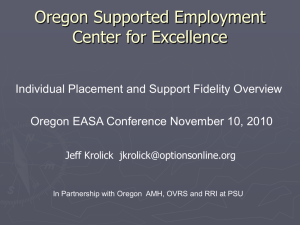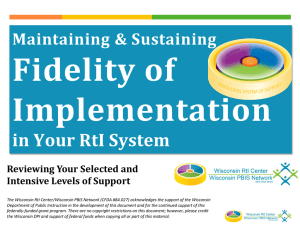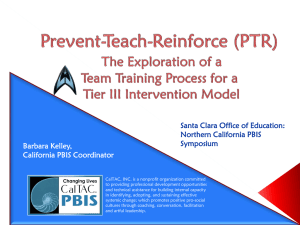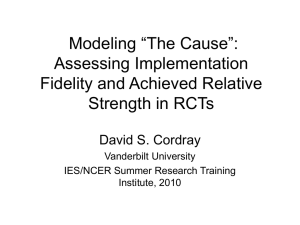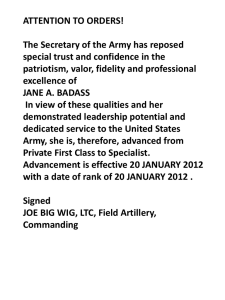PowerPoint - Wisconsin PBIS Network
advertisement
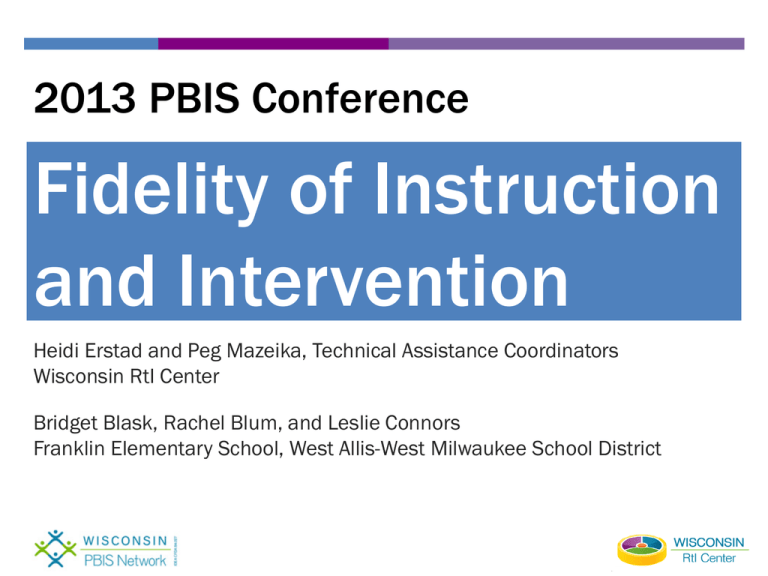
2013 PBIS Conference Fidelity of Instruction and Intervention Heidi Erstad and Peg Mazeika, Technical Assistance Coordinators Wisconsin RtI Center Bridget Blask, Rachel Blum, and Leslie Connors Franklin Elementary School, West Allis-West Milwaukee School District Wisconsin definition of RtI Is what? An organizational framework Does what? guides implementation of a multi-level system of support that to For what? achieve academic and behavioral success for all Fidelity of Implementation Fidelity of instruction and intervention Presentation Questions • What is it and why is it important? • What factors impact fidelity and what can you do to ensure fidelity? • What resources are available to help you in this process? • What does it look like in practice? Franklin’s story What is Fidelity of Instruction and Intervention? Some working definitions for this presentation: • Instruction: Teacher’s instructional behaviors (sounds like, looks like, feels like) • Intervention: Research- or evidence-based practice or program at any tier • Fidelity*: The degree to which the instruction and intervention are delivered as designed, with accuracy and consistency, and have intended results. *Adapted from National Center on RtI, n.d; Forbush, et al, 2009; Dunst, et al, 2008 Frequency, dosage, duration Modified from O’Donnell, 2008 Exposure Sticking to the plan; Using “active ingredients” Adherence Fidelity Quality of Delivery Use of “best practices” Engagement Active participation All students introduced via ‘Schoolwide Kick-Off’ and building & classroom matrices. Ongoing scheduled lessons, frequency and grouping occur based on data. Exposure Teachers follow schoolwide schedule of lessons and format (Cool tools, videos). Teachers follow classroom lessons. Adherence Fidelity in Tier 1 (Universal) Instruction Quality of Delivery Use of student modeling, examples/non-examples, frequent positive acknowledgement, teaching/re-teaching. Culturally responsive practices used. Engagement All students engaged in content, working toward schoolwide or classroom goals Staff implement intervention based on re-teaching Schoolwide Matrix or identified skills. Duration and time frame defined by research, student response data. Students attend sessions. Exposure Staff implement core components of interventions according to design and data based need. Adherence Fidelity in Tier 2 (Selected) Interventions Quality of Delivery Staff deliver planned content according to age and needs of students with progress monitoring. Engagement Students actively engaged throughout interventions working toward group or individual goals Staff follow predetermined duration and frequency based on team-developed individualized student plan to address student’s needs Exposure Staff adhere to individualized student plan and collect data to determine effectiveness Adherence Fidelity in Tier 3 (Intensive) Interventions Quality of Delivery Staff adjust instruction based on student responsiveness to plan / according to student data Engagement Student actively engaged throughout interventions working on individualized goals Why is fidelity important? “Only when effective practices are fully implemented should we expect positive outcomes. Implementation matters. Blasé & Fixsen, 2005 Fidelity of instruction and intervention Presentation Questions • What is it and why is it important? • What factors impact fidelity and what can you do to ensure fidelity? • What resources are available to help you in this process? • What does it look like in practice? Franklin’s story What factors impact fidelity? • Match to student / school need • Complexity of new skill or practice • Accessibility of resources • • Training, feedback, and support Number of competing priorities • Accountability • Perceived effectiveness • • Clarity of core components Professional culture of school (Protheroe, N., 2008) Consider this… Research-based practices inform when and how they interact with students and stakeholders, but it is the person who delivers the intervention through words and actions. Your staff are the intervention! Wallace, et al, 2008 What can you do to ensure fidelity? Accountability Quality control Quality assurance Support What can you do to ensure fidelity? SUPPORT Don’t skimp on professional learning! • Be clear about and build deep understanding of “active ingredients” of instruction and intervention • Over-estimate time, training, & support needed to develop fluency with new practices • Know that change occurs at the individual level; one size won’t fit all! What can you do to ensure fidelity? SUPPORT Add coaching! OUTCOMES: Percentage of Participants Who… Demonstrated Knowledge Demonstrated Skill Used Skill in Context Theory and Discussion 10% 5% 0% PLUS Demonstration in Training 30% 20% 0% PLUS Practice & Feedback in Training 60% 60% 5% PLUS Coaching in Context 95% 95% 95% TRAINING COMPONENTS Joyce & Showers, 2002 What can you do to ensure fidelity? SUPPORT Don’t skimp on supportive structures! • Anticipate difficulties with implementation of new practices • Provide and co-create staff manuals, checklists, “calibration checks,’ and guidelines • Create feedback loops What can you do to ensure fidelity? ACCOUNTABILITY • Continued monitoring is critical to success • Create a plan to monitor implementation • Analyze data to identify possible reasons for programs not performing as expected and action plan Fidelity of instruction and intervention Presentation Questions • What is it and why is it important? • What factors impact fidelity and what can you do to ensure fidelity? • What resources are available to help you in this process? • What does it look like in practice? Franklin’s story What resources are available to help? HANDOUT Resources to Support and Measure Fidelity of Instruction and Intervention What Does It Look Like in Practice? Franklin Elementary School, West Allis-West Milwaukee School District: • Bridget Blask, School Counselor • Rachel Blum, NxGLC, grades 1-3 • Leslie Connors, principal References Dunst, C. J., Trivette, C. M., McInerney, M., Holland-Coviello, R., Masiello, T., Helsel, F., & Robyak, A. (2008). Measuring training and practice fidelity in capacity-building scaling-up initiatives. CELLpapers, 3(1), 1-11. Available http://www.earlyliteracylearning.org/cellpapers/cellpapers_v3_n1.pdf. Forbus, D., Milbank C., & Hughes, J. (2011). Maximizing Student Outcomes – What does Instructional fidelity have To Do With It? EssentialEducator.org Johnson, E., Mellard, D., Fuchs, D. & McKnight, M. (2006). Responsiveness to intervention (RTI): How to do it. Lawrence, KS: National Research Center on Learning Disabilities Leonard-Barton, D. & Kraus, W. (1985). Implementing new technology. Harvard Business Review. 6, 102 – 110. Mellard, D., (2010). Fidelity of implementation within a Response to Intervention (RtI) framework: Tools for schools. National Center on Response to Intervention. National Center on RtI. (2009). Fidelity of implementation within an RtI framework. Available http://www.rti4success.org/pdf/FidelityImplementation_10-20-09_FINAL.pdf References National Research Center on Learning Disabilities. (August, 2006). RtI manual: Fidelity of implementation. Available http://www.nrcld.org North Dakota Department of Public Instruction. (n.d.). Fidelity of Implementation. Available http://www.dpi.state.nd.us/speced/personnel/fidelity.shtm Protheroe, N., (2008). The impact of fidelity of implementation in effective standards-based instruction. Principal, 38 – 42. SCRED. (2011). Implementation integrity within an RtI framework: Critical roles and tools for school psychologists. Available http://www.nasponline.org
